
Preservation Self-Assessment Program
Architectural Drawing Reproduction Cheatsheet
Photoreproduction
Ferro-Gallic Print (1859 – 1930s)

- Image
- Iron gallo-tannate pigment ink
- Identification
- Positive image on a light, probably yellowed or discolored, ground. Image lines are likely faded to brown or dull black. Image lines may appear either raised or burned into the support’s surface, depending on method of production. Multi-media and marginalia common.
- Preservation
-
- Residual acid in the print may cause yellowing and embrittlement of support.
- Acidic image material may cause lacing of the support.
- Sensitive to light, which will cause image lines to discolor, fade, or even disappear.
- Due to destructive off-gassing, should be stored separately from other formats.
- Avoid alkaline enclosures.
Aniline Print (1864 – 1890s)
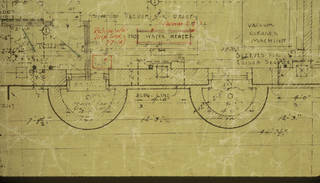
- Image
- Aniline dye-based ink
- Identification
- Ground has a distinctive greenish or yellowish tint, with lighter-colored verso (back). Positive image is low contrast with soft lines, most commonly violet, blue, or black. Aniline prints are rarely found in collections.
- Preservation
-
- Very sensitive to UV light, which will cause image fading.
- Sensitive to heat and high humidity.
- Residual chemicals in the print may result in discoloration, embrittlement, scratches, scuffs, and cracks.
- Avoid alkaline enclosures.
Blueprint (c. 1872 - present; technical uses, c. 1872 - 1950s)
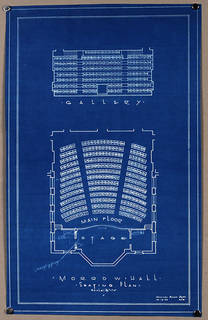
- Image
- Monochrome (Prussian blue pigment)
- Identification
- More commonly found as a negative image, but positive images were also made (“pellet prints”). Extremely matte surface with continuous tone and brilliant blue image.
- Preservation
-
- Very sensitive to light, otherwise relatively stable.
- Avoid alkaline enclosures.
VanDyke Print (c. 1890 – early 1960s)
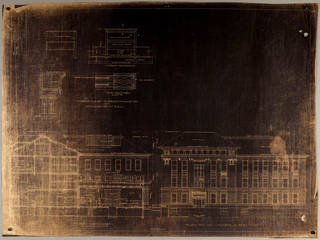
- Image
- Silver and iron
- Monochrome (brown/white)
- Identification
- High contrast image may be positive (final print) or negative (internegative). Negative prints have a cool brown ground with white lines, while positive prints have a white ground with cool brown lines similar in appearance to a sepia diazo print. Unlike the speckled "dirty" ground of a sepia diazo, the ground of a positive VanDyke print will appear uniform and clean. Blue staining may be visible on verso (back).
- Preservation
-
- Residual acid in the print may cause yellowing and weakening of support.
- Sensitive to air pollutants, heat, and high humidity.
Photostat (Architecture) (1909 – c. 1980, use declined after 1950)
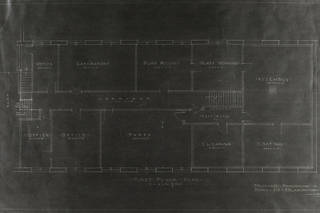
- Image
- Photographic silver (emulsion)
- Identification
- More commonly found as a negative image, but positive images were also made. Silver mirroring common. Usually high contrast black and white images.
- Preservation
-
- Prone to silvering and yellowing, especially if not properly washed.
- Sensitive to air pollutants, heat, and high humidity.
Wash-Off Print (1920s – present)
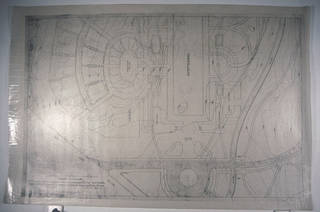
- Image
- Photographic silver (emulsion)
- Identification
- Positive image with strong ink-like black lines that appear to sit on the surface of the support in slight relief. The lines may exhibit a subtle metallic sheen. Ground is usually clean and smooth, but it may be littered with tiny black flecks left from emulsion. Image may be printed in reverse.
- Preservation
-
- Oxidized image lines may yellow or exhibit silver mirroring.
- Drafting cloth may discolor over time.
- Sensitive to air pollutants, heat, and high humidity.
Diazo Print (Architecture) (1923 – present)
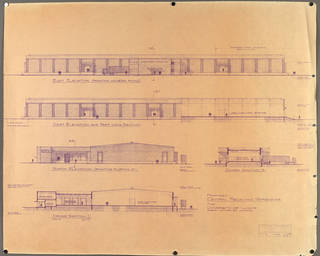
- Image
- Azo dye-based ink
- Identification
- Often seen with dirty, flecked ground and yellow discoloration especially along edges. If on paper, verso (back) is noticeably bright white in comparison to recto (front). May possess an ammonia odor.
- Preservation
-
- Paper likely embrittled and yellowed from residual chemicals.
- Exposure to heat and light will cause image fading.
- Due to destructive off-gassing, should be stored separately from other formats.
- Avoid alkaline enclosures.
Photomechanical (ink or toner on paper)
Hectograph Copy (Architecture) (c. 1870 – 1920s)
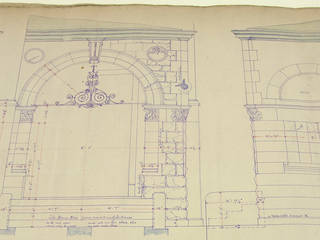
- Image
- Aniline dye-based ink
- Identification
- Similar in appearance to spirit duplicates and diazotypes. Printed on glossy, heavily surfaced paper with violet or blue aniline dyes, although multiple colors were sometimes used. Image lines are fuzzy with poor line definition.
- Preservation
-
- Very sensitive to UV light, which will cause image fading.
- Aniline dyes are water soluble; should not be exposed to high humidity or moisture.
- Avoid alkaline enclosures.
Gel-Lithograph (c. 1910 – 1950s)
- Image
- Carbon-based ink
- Identification
- May be identified by sharp, dense black image lines, which may be confused with an original drawing. Prints could be made in other colors, although black was most common.
- Preservation
-
- Color inks are dye-based, water soluble, light and heat sensitive.
- Stable overall; preservation risk depends primarily on quality of support material.
Electrostatic Print (Architecture) (c. 1940 – present; large format, c. 1960-present)

See Electrostatic Xerox Copy (Office).
Related Profiles
- Cyanotype (Photo): Monochromatic photographic print format with a similar process to blueprinting.
- Silver-Halide Processes: Microfilm, Microfiche, Silver Gelatin Negative.